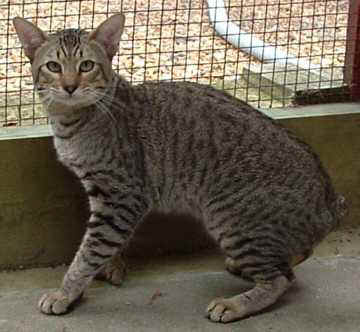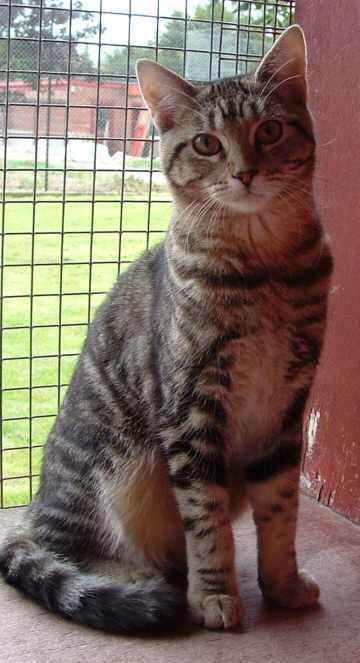Desert Lynx Breed Description
Information Provided by Mandy Berry
The tail may be the length of the
bobcat tail, which may come half way to the ground, or it may be lacking entirely, as in
the Manx, or it may be any length in between. Desert Lynx officially come in three coat
patterns in all eumelanistic colours--ebony, blue, sorrel, fawn, chocolate, and
lilac--including silvers, sepias, minks, and snows. The coat patterns are tawny (ticked),
leopard (spotted), and clouded leopard. However, it is not uncommon for them to occur in
red and cream colours.
The leopard pattern is a spotted
tabby pattern. It is marked by spots of the darker colour, most prominent on the sides of
the body and the belly. The spots may vary in size and shape, but should be evenly
distributed. Preference is given to rosette spots which are formed by a part-circle of
spots around a distinctly lighter centre. Contrast with ground colour may not be as
distinct as in some spotted breeds . A dorsal stripe runs the length of the body to the
tip of the tail. The stripe is ideally composed of spots. The markings on the face and
forehead are typical tabby markings, with the underside of the body having distinct spots.
Legs and tail are barred. In the sepia, mink, and snow subdivisions, it is desirable for
ghost leopard spots to appear on the bodies.
The tawny pattern is a ticked tabby
pattern marked by ticking on the body hair with various shades of the marking colour and
ground colour, with the outer tipping being the darkest and the undercoat being the ground
colour. The body may exhibit a barely perceptible spotted pattern. The tail, legs, and
face will have tabby pencil linings. Necklace tracings will are also frequently seen.
The clouded leopard pattern, while
derived from modifications to the classic tabby gene, is different from the classic tabby
pattern, with as little bull's eye similarities possible. The pattern gives the impression
of marble, preferably with a horizontal flow. Vertical stripes are undesirable. Contrast
should be good, with distinct shapes and sharp edges. The belly must be spotted.
Desert Lynx and Highland Lynx are
part of the same breed group in the Rare & Exotic Feline Registry. In other words,
Desert Lynx and Highland Lynx may be bred together. The curled-eared kittens may be
registered as Highland Lynx, and the straight-eared kittens may be registered as Desert
Lynx. The breeds are identical except for the ears. The curled ears of the Highland Lynx
are caused by a dominant gene which both curls the ears and somewhat reduces the size of
the ears. When the two breeds are bred together, the straight-eared kittens resulting from
the breeding do not carry any genes for curled
Feral bobcats, Lynx Rufus, inhabit
most of
Florida Everglades and northern
north into
The head is large but not round, with a full, well-developed muzzle that is almost square in appearance, with prominent whisker pads. The ears are large and set wide apart, usually with feathering and tufts on the tip. The wide set eyes are large and expressive, set at an angle, with colors ranging from gold to green, with blue eyes in the snows.
 |
 |